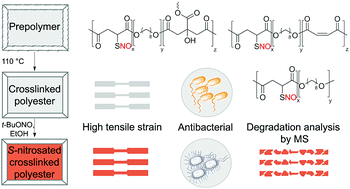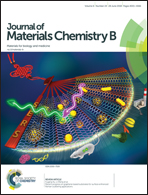Biodegradable crosslinked polyesters derived from thiomalic acid and S-nitrosothiol analogues for nitric oxide release†
Abstract
Crosslinked polyesters with Young's moduli similar to that of certain soft biological tissues were prepared via bulk polycondensation of thiomalic acid and 1,8-octanediol alone, and with citric or maleic acid. The copolymers were converted to nitric oxide (NO)-releasing S-nitrosothiol (RSNO) analogues by reaction with tert-butyl nitrite. Additional conjugation steps were avoided by inclusion of the thiolated monomer during the polycondensation to permit thiol conversion to RSNOs. NO release at physiological pH and temperature (pH 7.4, 37 °C) was determined by chemiluminescence-based NO detection. The average total NO content for poly(thiomalic-co-maleic acid-co-1,8-octanediol), poly(thiomalic-co-citric acid-co-1,8-octanediol), and poly(thiomalic acid-co-1,8-octanediol) was 130 ± 39 μmol g−1, 200 ± 35 μmol g−1, and 130 ± 11 μmol g−1, respectively. The antibacterial properties of the S-nitrosated analogues were confirmed against Escherichia coli and Staphylococcus aureus. The hydrolytic degradation products were analyzed by time-of-flight mass spectrometry after a 10 week study to investigate their compositions. Tensile mechanical tests were performed on the non-nitrosated polymers as well as their S-nitrosated derivatives and suggested that the materials have appropriate Young's moduli and elongation values for biomedical applications.



 Please wait while we load your content...
Please wait while we load your content...